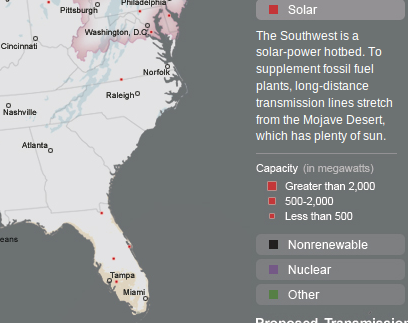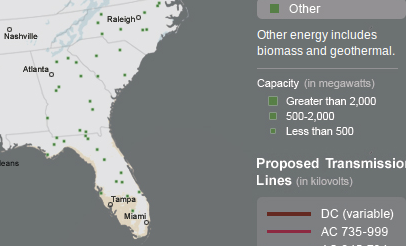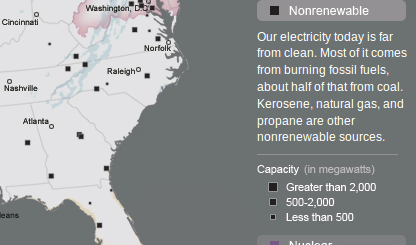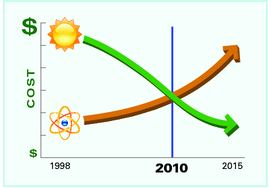On the right, Natasha Fast is explaining it to somebody.
First Friday, Valdosta, Lowndes County, Georgia, 3 September 2010, Pictures and videos by Gretchen Quarterman.
-jsq
On the right, Natasha Fast is explaining it to somebody.
First Friday, Valdosta, Lowndes County, Georgia, 3 September 2010, Pictures and videos by Gretchen Quarterman.
-jsq
Who does know?
We are mapping all of the existing, proposed, closed and defeated dirty energy and waste facilities in the United States. We are building a network of community groups to fight the facilities and the corporations behind them.The detail map shown includes the Wiregrass Power LLC proposed plant (the orange oval I just south of Valdosta), two plants in Hamilton County, Florida Continue reading
 Georgia EPD approved the air quality permit for the Wiregrass Power LLC
biomass plant on Perimeter Road just outside Valdosta in Lowndes County,
with an effective date of July 19, 2010 (PDF, Word).
Somebody may want to do the exercise of comparing the approved permit
with the application to see if the process was entirely
rubberstamp or whether any changes at all were made after
the many questions
people asked at the
public hearing.
Georgia EPD approved the air quality permit for the Wiregrass Power LLC
biomass plant on Perimeter Road just outside Valdosta in Lowndes County,
with an effective date of July 19, 2010 (PDF, Word).
Somebody may want to do the exercise of comparing the approved permit
with the application to see if the process was entirely
rubberstamp or whether any changes at all were made after
the many questions
people asked at the
public hearing.
Meanwhile, is that it? Will the plant be built? Not necessarily: Continue reading
 Here’s an interesting
video interview
with Dr. William Sammons,
the doctor who spoke in Traverse City just before that biomass plant was nixed.
Here’s an interesting
video interview
with Dr. William Sammons,
the doctor who spoke in Traverse City just before that biomass plant was nixed.
Is it more important to reach the target … or to say we have new information and we need to revise the targets and what qualifies?He’s talking about potential billions of dollars of health costs from particulates, about “waste” wood (what they say they will burn) vs. whole trees (what they end up burning), and most importantly about sustainability.
Biomass plants don’t have to report their CO2 emissions, so if all the proposed biomass plants get built we’re talking about as much as 800 million tons of CO2 from biomass plants by 2020, 12 to 14% of total CO2 emissions for the U.S. (not just power emissions: total national emissions). Trees don’t grow fast enough to suck all that back out of the air in ten years. Continue reading
 OK, let’s look at “solar” in the
online interactive map from
Joel Achenbach’s story about
The 21st Century Grid
in the July 2010 National Geographic.
It’s easy to count the proposed solar power plants in Georgia: zero.
Yet there’s one in Virginia, one in Maryland, and at least three in Florida,
adding to the
currently largest solar plant in the country near De Soto, Florida.
The map legend repeats the GEFA canard that
OK, let’s look at “solar” in the
online interactive map from
Joel Achenbach’s story about
The 21st Century Grid
in the July 2010 National Geographic.
It’s easy to count the proposed solar power plants in Georgia: zero.
Yet there’s one in Virginia, one in Maryland, and at least three in Florida,
adding to the
currently largest solar plant in the country near De Soto, Florida.
The map legend repeats the GEFA canard that
The Southwest is a solar-power hotbed. To supplement fossil fuel plants, long-distance transmission lines stretch from the Mojave Destert, which has plenty of sun.
 Yes, that’s true, but what about this.
At least three solar plants are proposed around San Antonio and Austin,
which are not in the area of the southwest the map blurb is referring to.
In fact, the largest solar plant in the country is proposed for Austin.
Austin is one degree of latitude south of Valdosta,
and has been leading the country in solar deployment for many years now.
Texas in general
almost doubled renewable energy generation between 2004 and 2006
while Georgia did nothing.
Texas hasn’t stopped.
When will Georgia start?
Yes, that’s true, but what about this.
At least three solar plants are proposed around San Antonio and Austin,
which are not in the area of the southwest the map blurb is referring to.
In fact, the largest solar plant in the country is proposed for Austin.
Austin is one degree of latitude south of Valdosta,
and has been leading the country in solar deployment for many years now.
Texas in general
almost doubled renewable energy generation between 2004 and 2006
while Georgia did nothing.
Texas hasn’t stopped.
When will Georgia start?
The Austin solar solution doesn’t require massive new power lines, either. It’s mostly been accomplished with solar panels on houses and business roofs; panels that wouldn’t show up on National Geographic’s map because they’re small and distributed. Which is the point: they generate power where it’s needed, and at peak times when it’s needed, namely when it’s hot and sunny out and air conditioners are running on max. There’s no reason Georgia can’t do the same.
I would continue this series by showing wind generation proposed for Georgia, but there isn’t any of that, either. There could be, off the coast.
Which makes more sense: polluting our air with more coal and biomass plants, or getting a move on with solar and wind?
-jsq
 Let’s select “other” in the
online interactive map from
Joel Achenbach’s story about
The 21st Century Grid
in the July 2010 National Geographic.
This map clearly shows the proposed Wiregrass LLC plant in Valdosta,
as well as two plants proposed just to the south for Hamilton County, Florida,
and one in Echols County, Georgia, which presumably would
be the Oglethorpe Power alternative site.
Several of the other plants shown are probably the other proposed Oglethorpe
Power plants.
Missing is Georgia Power’s Plant Mitchell in Albany, which is supposed
to convert from coal to biomass.
(Also if you select “nuclear”, the two Georgia Power proposed nuclear plants
on the Savannah River are missing.)
Apparently National Geographic edoesn’t have a complete list of proposed
biomass plants.
I wonder who does, if anybody?
Let’s select “other” in the
online interactive map from
Joel Achenbach’s story about
The 21st Century Grid
in the July 2010 National Geographic.
This map clearly shows the proposed Wiregrass LLC plant in Valdosta,
as well as two plants proposed just to the south for Hamilton County, Florida,
and one in Echols County, Georgia, which presumably would
be the Oglethorpe Power alternative site.
Several of the other plants shown are probably the other proposed Oglethorpe
Power plants.
Missing is Georgia Power’s Plant Mitchell in Albany, which is supposed
to convert from coal to biomass.
(Also if you select “nuclear”, the two Georgia Power proposed nuclear plants
on the Savannah River are missing.)
Apparently National Geographic edoesn’t have a complete list of proposed
biomass plants.
I wonder who does, if anybody?
Nonetheless, take this map of proposed biomass plants and combine it with the map of proposed new coal plants, plus the existing coal plants in Juliette, Georgia (dirtiest in the country) and Albany, and south Georgia is slated to become even more infested with polluting energy sources.
Does that seem like a good idea to you?
Next: proposed solar plants.
-jsq
 In the July 2010 National Geographic,
Joel Achenbach writes about
The 21st Century Grid.
It’s mostly about how we need a smart grid and additional power lines
to redistribute power better,
but it does get into proposed power plants to generate new power.
In the July 2010 National Geographic,
Joel Achenbach writes about
The 21st Century Grid.
It’s mostly about how we need a smart grid and additional power lines
to redistribute power better,
but it does get into proposed power plants to generate new power.
Although everyone acknowledges the need for a better, smarter, cleaner grid, the paramount goal of the utility industry continues to be cheap electricity. In the U.S. about half of it comes from burning coal. Coal-powered generators produce a third of the mercury emissions in America, a third of our smog, two-thirds of our sulfur dioxide, and nearly a third of our planet-warming carbon dioxide—around 2.5 billion metric tons a year, by the most recent estimate.Then it talks about how it’s hard to get stodgy electric utilities to invest in anything else. However, there is at least one way:
A California law requires utilities to generate at least 20 percent of their electricity from renewable sources as of this year.OK, so what new energy plant are proposed for Georgia? The online interactive map lets you select different energy types. The map above shows four proposed new coal plants in Georgia, surrounding south Georgia (plus something nonrenewable in Florida near Tampa). I recognize the one in far southwest Georgia as the one proposed for Early County and fortunately still tied up in litigation. All four are in addition to the existing Plant Scherer at Juliett, GA, near Macon, the dirtiest coal plant in the country, and the one that generates 2/3 of our power for south Georgia (as well as selling a lot of power to Florida). Adding still more dirty coal plants does not look like progress.
Continued in next blog entry.
-jsq
 John O. Blackburn and Sam Cunningham
write about
Solar and Nuclear Costs — The Historic Crossover:
Solar Energy is Now the Better Buy
John O. Blackburn and Sam Cunningham
write about
Solar and Nuclear Costs — The Historic Crossover:
Solar Energy is Now the Better Buy
Solar photovoltaic system costs have fallen steadily for decades. They are projected to fall even farther over the next 10 years. Meanwhile, projected costs for construction of new nuclear plants have risen steadily over the last decade, and they continue to rise. In the past year, the lines have crossed in North Carolina. Electricity from new solar installations is now cheaper than electricity from proposed new nuclear plants. This new development has profound implications for North Carolina’s energy and economic future. Each and every stakeholder in North Carolina’s energy sector — citizens, elected officials, solar power installers and manufacturers, and electric utilities — should recognize this watershed moment.And North Carolina is north of Georgia, so Georgia should have more sun.
-jsq
 Every year the Lowndes County Democratic Party (LCDP)
has a barbecue to which it invites candidates for public office.
These include local candidates. Here we have the two Democrats
running for Lowndes County Commission in District 2, in alphabetical order:
Debra M. Franklin
and
John S. Quarterman.
Notice the two candidates dining amicably side by side.
Every year the Lowndes County Democratic Party (LCDP)
has a barbecue to which it invites candidates for public office.
These include local candidates. Here we have the two Democrats
running for Lowndes County Commission in District 2, in alphabetical order:
Debra M. Franklin
and
John S. Quarterman.
Notice the two candidates dining amicably side by side.
Debra M. Franklin: Continue reading
 This is part 2 about the July 8th
town Hall meeting about the biomass plant proposed for Valdosta.
This is part 2 about the July 8th
town Hall meeting about the biomass plant proposed for Valdosta.
First let’s hear George Rhynes explain that it’s never too late to reregulate our minds:
Here I’ve selected videos of local County Commission candidates: Continue reading